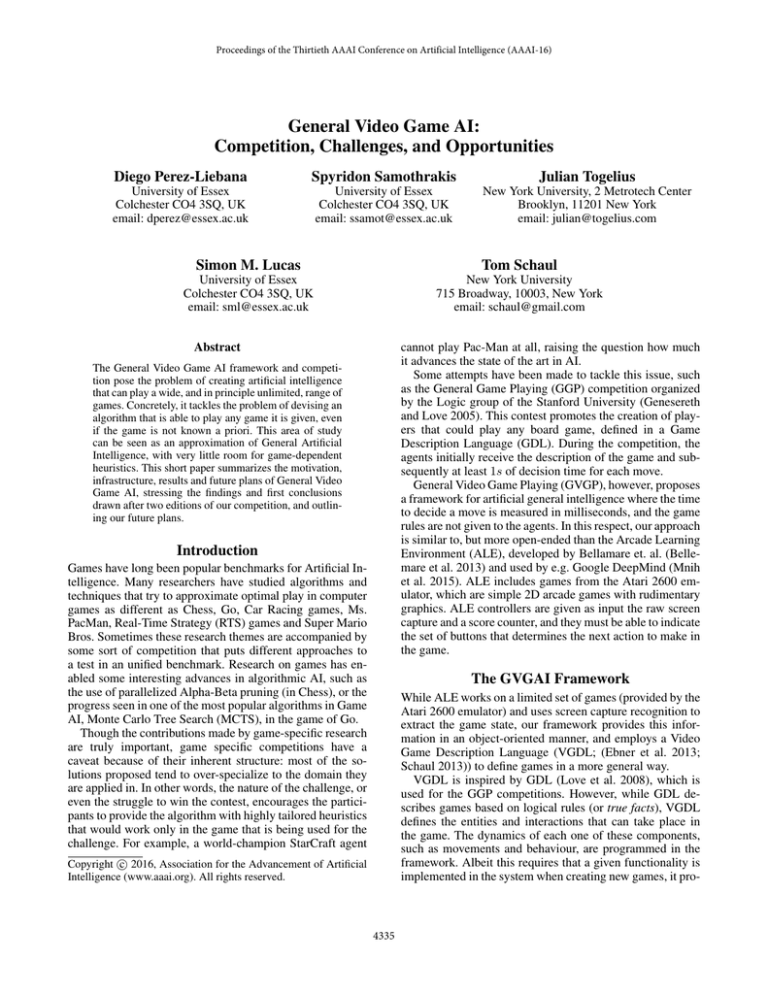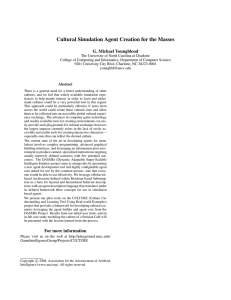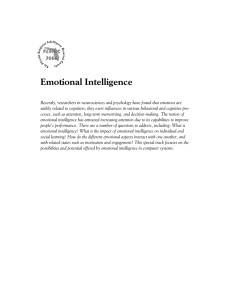
Proceedings of the Thirtieth AAAI Conference on Artificial Intelligence (AAAI-16)
General Video Game AI:
Competition, Challenges, and Opportunities
Diego Perez-Liebana
Spyridon Samothrakis
Julian Togelius
University of Essex
Colchester CO4 3SQ, UK
email: dperez@essex.ac.uk
University of Essex
Colchester CO4 3SQ, UK
email: ssamot@essex.ac.uk
New York University, 2 Metrotech Center
Brooklyn, 11201 New York
email: julian@togelius.com
Simon M. Lucas
Tom Schaul
University of Essex
Colchester CO4 3SQ, UK
email: sml@essex.ac.uk
New York University
715 Broadway, 10003, New York
email: schaul@gmail.com
cannot play Pac-Man at all, raising the question how much
it advances the state of the art in AI.
Some attempts have been made to tackle this issue, such
as the General Game Playing (GGP) competition organized
by the Logic group of the Stanford University (Genesereth
and Love 2005). This contest promotes the creation of players that could play any board game, defined in a Game
Description Language (GDL). During the competition, the
agents initially receive the description of the game and subsequently at least 1s of decision time for each move.
General Video Game Playing (GVGP), however, proposes
a framework for artificial general intelligence where the time
to decide a move is measured in milliseconds, and the game
rules are not given to the agents. In this respect, our approach
is similar to, but more open-ended than the Arcade Learning
Environment (ALE), developed by Bellamare et. al. (Bellemare et al. 2013) and used by e.g. Google DeepMind (Mnih
et al. 2015). ALE includes games from the Atari 2600 emulator, which are simple 2D arcade games with rudimentary
graphics. ALE controllers are given as input the raw screen
capture and a score counter, and they must be able to indicate
the set of buttons that determines the next action to make in
the game.
Abstract
The General Video Game AI framework and competition pose the problem of creating artificial intelligence
that can play a wide, and in principle unlimited, range of
games. Concretely, it tackles the problem of devising an
algorithm that is able to play any game it is given, even
if the game is not known a priori. This area of study
can be seen as an approximation of General Artificial
Intelligence, with very little room for game-dependent
heuristics. This short paper summarizes the motivation,
infrastructure, results and future plans of General Video
Game AI, stressing the findings and first conclusions
drawn after two editions of our competition, and outlining our future plans.
Introduction
Games have long been popular benchmarks for Artificial Intelligence. Many researchers have studied algorithms and
techniques that try to approximate optimal play in computer
games as different as Chess, Go, Car Racing games, Ms.
PacMan, Real-Time Strategy (RTS) games and Super Mario
Bros. Sometimes these research themes are accompanied by
some sort of competition that puts different approaches to
a test in an unified benchmark. Research on games has enabled some interesting advances in algorithmic AI, such as
the use of parallelized Alpha-Beta pruning (in Chess), or the
progress seen in one of the most popular algorithms in Game
AI, Monte Carlo Tree Search (MCTS), in the game of Go.
Though the contributions made by game-specific research
are truly important, game specific competitions have a
caveat because of their inherent structure: most of the solutions proposed tend to over-specialize to the domain they
are applied in. In other words, the nature of the challenge, or
even the struggle to win the contest, encourages the participants to provide the algorithm with highly tailored heuristics
that would work only in the game that is being used for the
challenge. For example, a world-champion StarCraft agent
The GVGAI Framework
While ALE works on a limited set of games (provided by the
Atari 2600 emulator) and uses screen capture recognition to
extract the game state, our framework provides this information in an object-oriented manner, and employs a Video
Game Description Language (VGDL; (Ebner et al. 2013;
Schaul 2013)) to define games in a more general way.
VGDL is inspired by GDL (Love et al. 2008), which is
used for the GGP competitions. However, while GDL describes games based on logical rules (or true facts), VGDL
defines the entities and interactions that can take place in
the game. The dynamics of each one of these components,
such as movements and behaviour, are programmed in the
framework. Albeit this requires that a given functionality is
implemented in the system when creating new games, it pro-
c 2016, Association for the Advancement of Artificial
Copyright Intelligence (www.aaai.org). All rights reserved.
4335
vides more flexibility and a larger space of games that can be
designed. While GDL is restricted to board games, VGDL
enables the definition of a wide range of arcade and puzzle
games.
VGDL allows for the definition of 2-dimensional singleplayer games and levels with text files. Different types of
sprites can be defined, parametrized, given a 2D position and
a rectangular size. Interactions between sprites occur when
they collide with each other, and the consequences are defined in the game rules. For a full description of how games
and levels are defined in VGDL, see (Schaul 2013). Currently about 80 games are implemented in VGDL, including
versions of classic eighties games such as Pac-Man, Boulder
Dash, and Space Invaders.
The GVGAI framework, written in Java, provides an
object-oriented interface for creating agents that can play in
any game defined in VGDL. As defined in the initial track of
the competition (Planning track), an agent suitable to work
in this framework must be able to indicate moves in a realtime fashion. After a short initialization phase, the agent receives calls at every game step and must return a discrete
action to apply in no more than 40ms.
The agent receives information about the game state via a
Java object. This object allows the agent to query the game
status (winner, time step, score), the player’s state (position,
orientation, resources), history of events or collisions during
the game, and position of the different sprites in the level,
identified only by an integer id for its type. Note that the
rules of the game, the dynamics of the present sprites, or
the victory requirements are never provided to the player. It
is the agent’s responsibility to discover the game mechanics
while playing. Additionally, one of the main resources the
agents have to reason about the environment is the forward
model provided by the framework. This tool allows the agent
to simulate actions and roll the game forward to one of the
possible next states (the transition may be stochastic).
IEEE CIG and IEEE CEEC. The total number of submissions received for this edition was higher than 70, with different approaches such as tree search methods, evolutionary
algorithms (EA) and combinations of different techniques.
The winner of the GECCO 2015 leg, YOLOBOT, put forth
a combined approach between MCTS, Breadth First Search
and targeting heuristics. The winning entry at CIG 2015, Return42, submitted a multiple heuristic controller based on an
evolutionary algorithm, random walks and A*. Finally, the
winners of the CEEC 2015 leg, YBCriber, combined reactive avoidance of hazards with Iterative Widening (IW) in
their tree search algorithm.
Conclusions: Challenges and Opportunities
It seems clear that the challenge posed by GVGAI is far from
solved. To begin with, the competitions received multiple
entries with very different approaches, and no one particular
algorithm dominates the rest. In fact, it seems that trying to
analyze the type of game played, and selecting one or another algorithm in sequence (as a sort of Hyper-Heuristic)
improves the results obtained. Additionally, the average of
games won by the different winners across all editions of
the contest is around 50%. This indicates that the best controllers lose approximately 1 out of every 2 games.
The future of the GVGAI competition, however, is not
limited to the Planning track. The following tracks are currently in preparation:
• 2/N-Player track: Enhancement of VGDL and the GVGAI
framework to allow multi-player games for competition
and/or collaboration between agents.
• Learning track: A track with no forward model, where the
agents will play each game a determined (large) number
of times before being evaluated.
• Procedural Content Generation track: the submission will
consist of a general level generator, able to automatically
create levels for any game it is given.
The GVGAI Competitions
Currently only the Planning track of the competition is running. It works as follows: competitors use on one or more
sets of available games to train on (all games are provided
with 5 different levels). Additionally, there is a competition
server1 set up to receive submissions and run the controllers
on an unknown set of 10 games for validation. Participants
can submit multiple times to this set of games, and a ranking table is provided on the website. The contestants do not
have access to these secret games nor the levels bundled with
them. The final rankings are obtained from the execution of
all submissions in a third (secret) set of 10 games. For more
details on the rules and sets of games, see (Perez et al. 2015).
Two editions of the GVGAI competition have taken
place at the time of this writing. The first, held during the
IEEE Conference on Computational Intelligence and Games
(CIG) in 2014, received 14 submissions, and it was won
by Adrien Couëtoux, with an approach inspired by Hierarchical Open-Loop Optimistic Planning. The second edition,
was associated with three 2015 conferences: ACM GECCO,
1
Other modifications in mind are games with continuous
action spaces, analysis of the game state via screen capture
and games with partial observability. GVGAI has proven to
be an interesting challenge, hence it has captured the interest
of many researchers. Our current and future plans for this
framework and competition will open and maintain several
lines of interesting research for the game AI community.
References
Bellemare, M. G.; Naddaf, Y.; Veness, J.; and Bowling, M.
2013. The arcade learning environment: an evaluation platform for general agents. Journal of Artificial Intelligence
Research 47(1):253–279.
Ebner, M.; Levine, J.; Lucas, S.; Schaul, T.; Thompson, T.;
and Togelius, J. 2013. Towards a Video Game Description
Language. Dagstuhl Follow-up 6:85–100.
Genesereth, M., and Love, N. 2005. General Game Playing:
Overview of the AAAI Competition. AI Magazine 26:62–
72.
www.gvgai.net
4336
Love, N.; Hinrichs, T.; Haley, D.; Schkufza, E.; and Genesereth, M. 2008. General game playing: Game description
language specification.
Mnih, V.; Kavukcuoglu, K.; Silver, D.; Rusu, A. A.; Veness,
J.; Bellemare, M. G.; Graves, A.; Riedmiller, M.; Fidjeland,
A. K.; Ostrovski, G.; Petersen, S.; Beattie, C.; Sadik, A.;
Antonoglou, I.; King, H.; Kumaran, D.; Wierstra, D.; Legg,
S.; and Hassabis, D. 2015. Human-level control through
deep reinforcement learning. Nature 518(7540):529–533.
Perez, D.; Samothrakis, S.; Togelius, J.; Schaul, T.; Lucas,
S.; Couëtoux, A.; Lee, J.; Lim, C.-U.; and Thompson, T.
2015. The 2014 General Video Game Playing Competition.
IEEE Transactions on Computational Intelligence and AI in
Games (to appear) DOI: 10.1109/TCIAIG.2015.2402393.
Schaul, T. 2013. A Video Game Description Language for
Model-based or Interactive Learning. In Proceedings of the
IEEE Conference on Computational Intelligence in Games,
193–200. Niagara Falls: IEEE Press.
4337



